Trine is a physics-driven puzzle-platformer about three heroes who team up to save a high fantasy kingdom from an undead invasion. The plot kicks off when a Thief, a Wizard, and a Knight are drawn to a magical artifact known as the Trine. The trio are absorbed by the object and their souls combined into a single entity, each able to physically manifest one at a time while the other two exist as voices in their head. The quarrelsome heroes set out to free themselves from the Trine’s spell, but the assault of an undead army that appears at the same time as their entanglement hints at their unwitting involvement in another plot. I play as the trio as they learn to exploit their unique existence to traverse fifteen stages in search of a way to stop the undead army and disentangle themselves from each other and from the Trine.
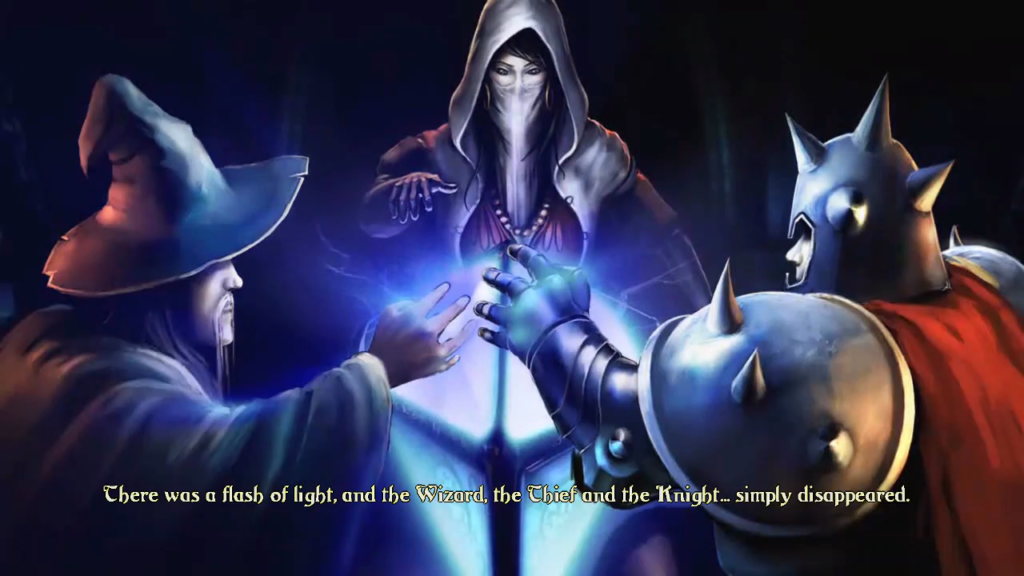
It’s important to note that this review is specifically based on the Enchanted Edition of Trine. This updated version was released after Trine 2 and incorporates several of its quality of life improvements. Though it is unlikely that players will find anything but the Enchanted Edition on current storefronts, my comments here should still broadly apply to Trine’s original release. Please be aware there may be some differences.
I play Trine by using the abilities of the three player characters to work their way across side-scrolling, puzzle-platforming stages. I can only play as one of the trio at a time. With the press of a button, I can shift which of the trio is in play, who appears instantly in a flash of light where their companion previously stood. Each character has distinct abilities that allow them to solve certain problems. Recognizing which character should be used and when is the first step towards solving Trine’s many puzzles.
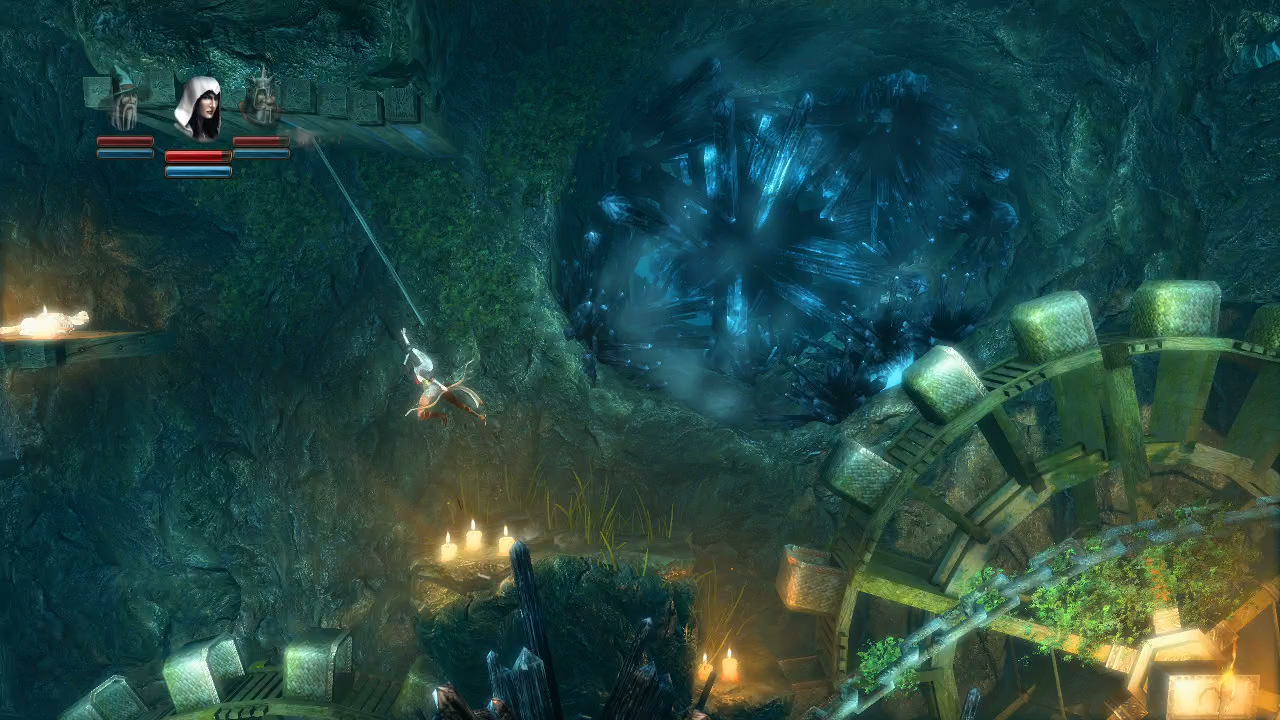
The Thief is far and away the character I use most. She moves slightly faster than her companions, but her most useful ability is a grappling hook she can embed into wooden objects. This tool lets her pull herself to high platforms or swing across wide gaps, trivializing or outright eliminating much of the platforming aspects of puzzle-platforming. She is also equipped with a bow and arrow to target skeleton soldiers from a distance.
What the Knight lacks in the Thief’s acrobatic prowess he makes up for with brute strength. He carries a sword which can bash enemy skeletons into bone piles with a few swings. He also carries an impenetrable shield which may be pointed in any direction to absorb enemy attacks or bursts of flame from environmental traps. His shield can also grab onto objects and toss them. Not once do I use this ability thanks to the final member of the trio.
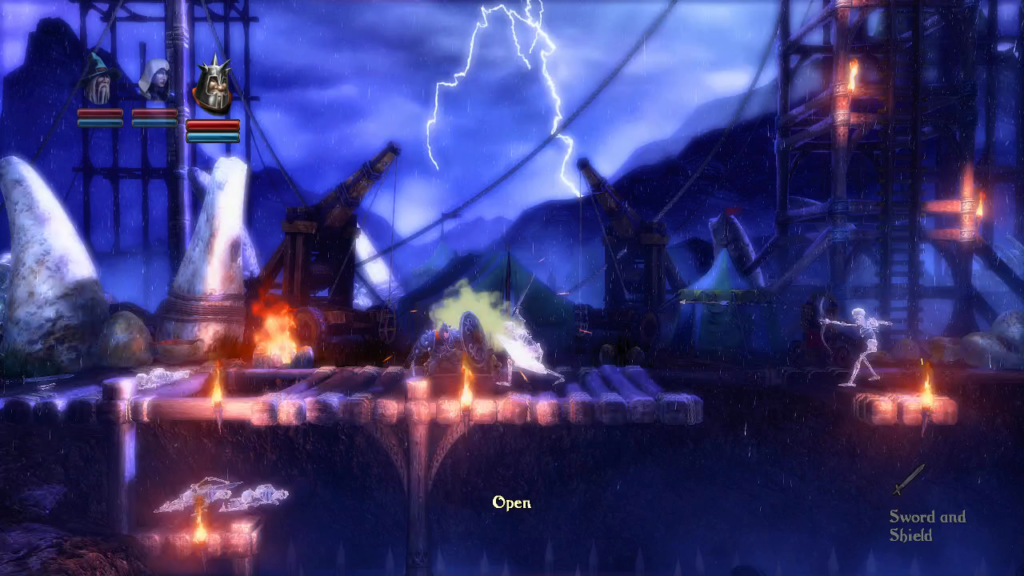
The Wizard is terrible at his job. With long white hair and a beard beneath a pointed blue hat, he looks like a stereotypical Wizard. But as he enters the story he is struggling to cast the basic Fireball spell. Every time he tries, he instead conjures boxes and planks. The only spell he can cast reliably is levitation, letting him lift and move any object on screen. Luckily for the Wizard, his ability at conjuration and levitation, while making him an embarrassing Wizard, make him an invaluable party member for puzzle platforming. Though he lacks the offensive capabilities of his partners, there are many obstacles that can only be bypassed by building a tower of boxes and climbing to its top to reach a platform or bypass an obstacle.
I quickly pigeonhole this trio into specific niches based on their abilities. When skeletons are on screen, I play as the Knight to fight them with furious and thoughtless mashing of the attack button. When I’m moving through a stage, I play as the Thief, using her increased speed to zoom across platforms and her grappling hook to clear the many bottomless pits. When I encounter an impassable barrier, I play as the Wizard, moving obstacles with levitation and building structures out of conjured boxes and planks. It never occurs to me to employ the heroes in any other situations because there’s no reason to. Their abilities have no practical application outside of these rigid tasks. I wish some puzzles gave more reason to have the three play off each other’s unique skills, but their design simply doesn’t allow for this.
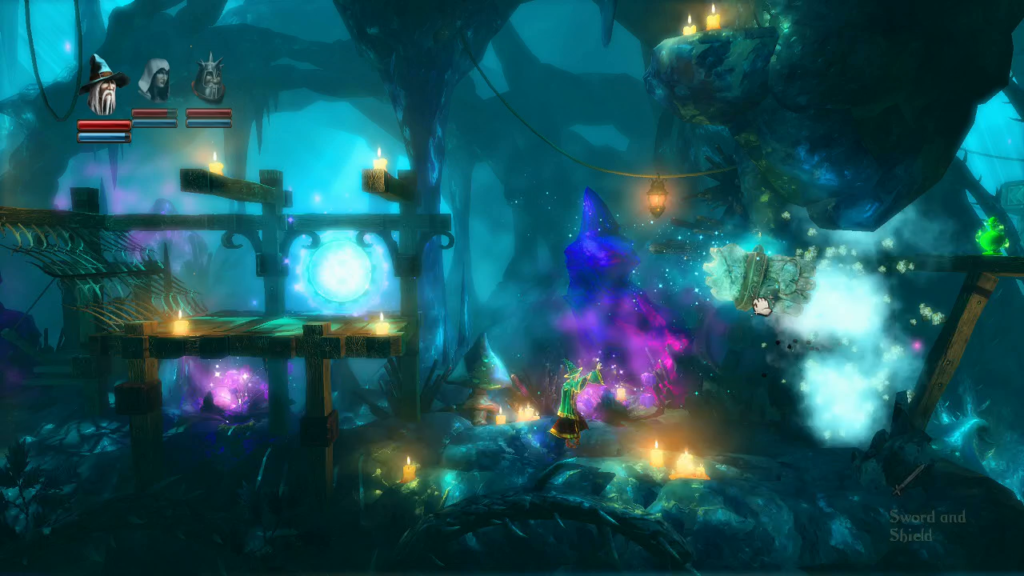
Trine dates from the distant and mysterious year of 2009 when physics-driven systems were still new and impressive in videogames. Interacting with these systems is what drives most of its puzzles. The Wizard deals with them most, lifting heavy blocks to use as counterweights on conveniently scale-shaped platforms or launching fist-shaped stones to punch through fragile walls. The Thief’s grappling hook is also heavily based around simulated physics, letting her swing back and forth to gain momentum and cover long distances.
Like most videogame physics systems, especially among Trine’s contemporaries, everything feels a little off. When the Knight defeats skeletons, their lifeless joints bend around corners with exaggerated contortion. Conjured boxes and planks can topple on uneven terrain with comical slowness, as though the Wizard is also an accidental master of time dilation spells. The Thief can leap from her grappling hook at unlikely angles, letting her ignore momentum to jump from the apex of her swing backwards onto the platform to which the hook was just attached.
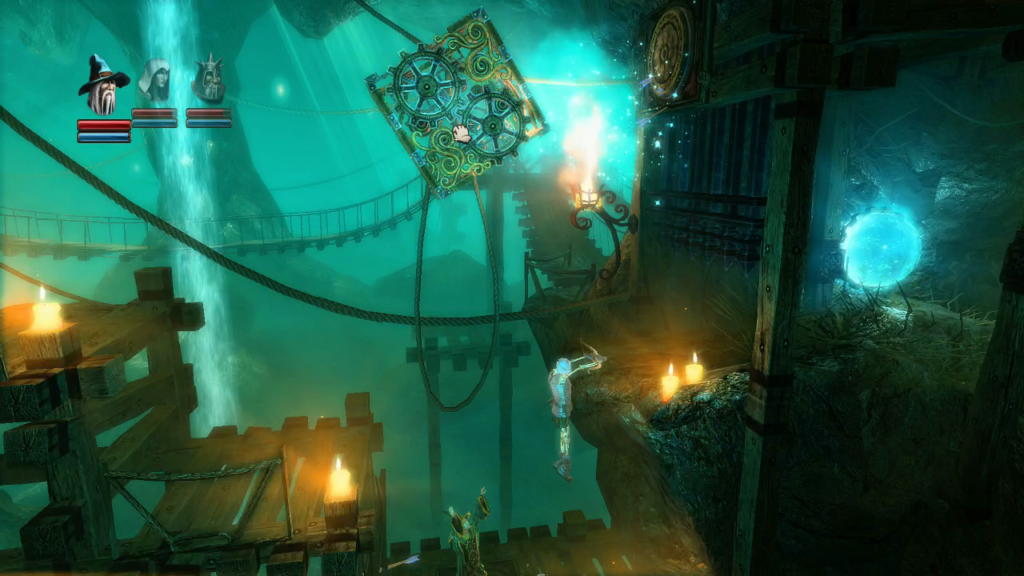
These aren’t complaints. Trine’s wonky physics is where it derives much of its charm. Levitated objects feel a little too heavy. Defeated enemies suddenly collapse, as though gaining hundreds of pounds of weight, then bounce off the floor as though they weigh nothing. I find the Thief can often perform an additional jump if I mash the button as she impacts a wall, and I’m uncertain if this is a designed wall jump or an exploitable quirk in the physics systems. After a while I quit wondering. Intended or not, the ability is too useful to ignore. Few, if any other videogames feel quite like Trine and this is what makes it most memorable.
Scattered across the stages are potions. They are placed high and low, but almost never along the direct path, forcing the trio to spend a little extra time working to reach them. Obtaining these prizes are where Trine’s physics system is put to its heaviest use.
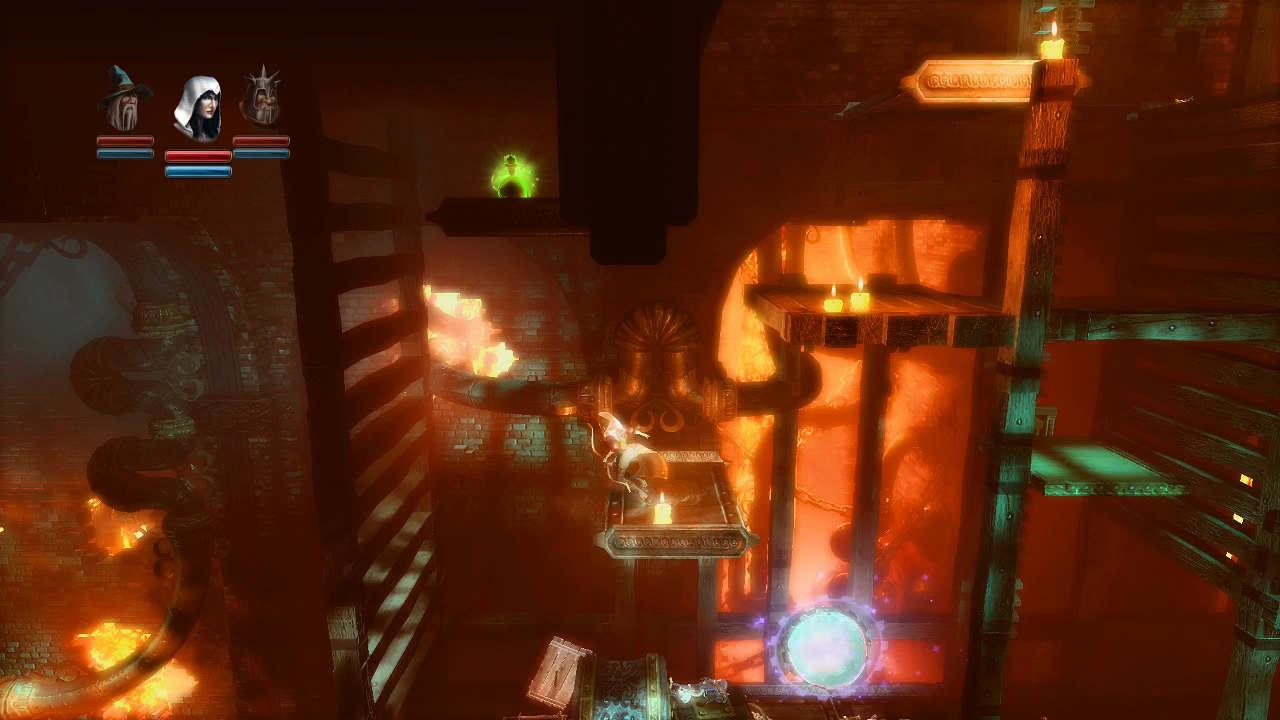
The number of options to reach potions is impressive. Most are placed with no obvious intended solution for reaching them. Potions perched on a high ledge may be reached by stacking conjured boxes with the Wizard or using the Thief’s grappling hook to pull herself up to them. They can also be pushed down with a levitated object, or shot with an arrow from the Thief’s bow. Finding all the potions in a stage is the main reason to replay them. A counter shows how many have been found and how many remain, though there is little reason to find them all besides sheer stubbornness.
Each stage also contains two hidden treasure chests which hold a valuable magic item. Chests are hidden with more cunning than potions, often placed just offscreen from the main path or obscured behind foreground decorations. Some require additional physics puzzles to be solved before they may be reached.
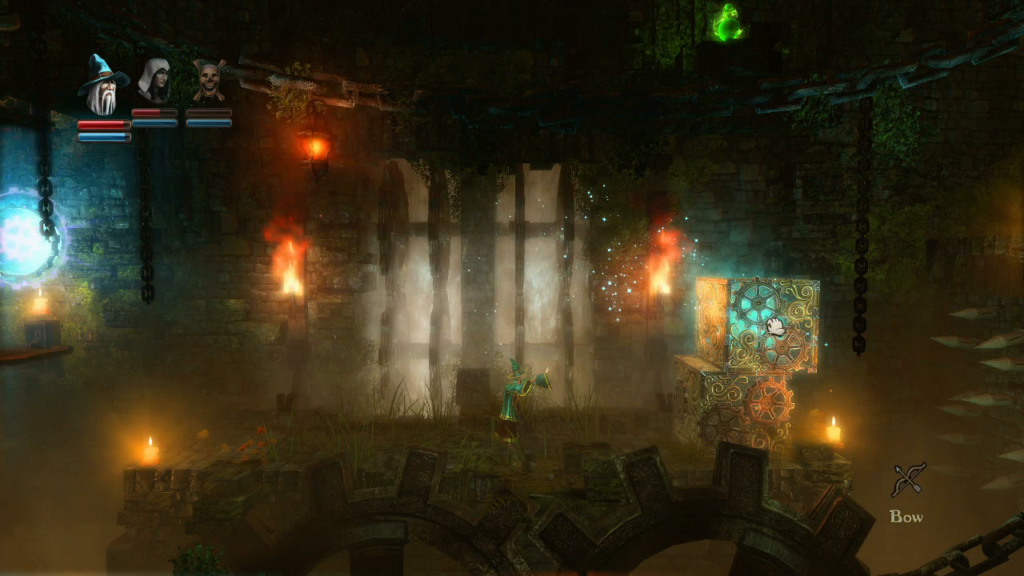
Potions and treasures form the foundation of Trine’s rudimentary RPG character development. Gathering one hundred awards each of the trio an experience level, letting them boost one of their three core skills. For the Knight and Thief, this generally means making their attacks stronger and more efficient. The Wizard benefits the most from gaining experience levels, increasing the number of crates and planks he may conjure at once. At high levels, he may build huge stair sets and bridges he can use to essentially ignore most puzzle-platforming segments. There are few skills and it’s easy to reach the highest experience levels through diligent potion collecting, so every player’s trio winds up having the same skill point distribution by the final stage.
Treasures are more impactful. Each offers a unique bonus, such as increased life, passive health regeneration, or additional boosts to each player character’s primary skills. Any item may be traded freely between the trio, so this is where I may create my most unique expression of Trine’s player characters. Depending on how I distribute discovered treasures, my Knight may take far more punishment and deal far more damage than another player’s.
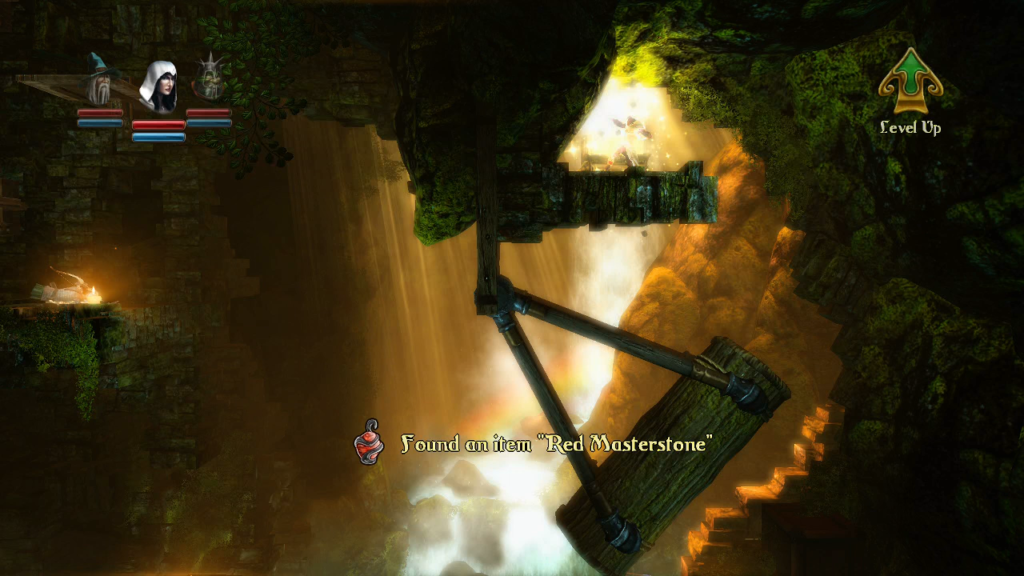
When one of the trio dies from trap damage, an enemy skeleton, or from a bottomless pit, it is not the end for their partners. The deceased player character becomes temporarily unavailable, but I may continue to switch between the other two without limitation. Often not having one of the trio means a death sentence for the other two, but it is sometimes possible to scramble through a tough platforming section without the Thief or from a scrum of skeleton warriors without the Knight. These moments are Trine’s most exciting and they feel discouragingly rare.
Strewn across every stage are many checkpoints that take the form of magic mirrors. Passing in front of these mirrors instantly regenerates the party, resurrecting the dead and healing the living. Amusingly, there’s no limit to how often this effect can happen, so if I choose to fight a pack of skeletons in front of a mirror then any resulting deaths are immediately undone. Standing in front of a mirror makes the party effectively immortal. If all three player characters do die, then they are taken back to the last mirror they passed. Mirrors are placed liberally, ensuring I never lose more than a few minutes of progress should the worst happen.
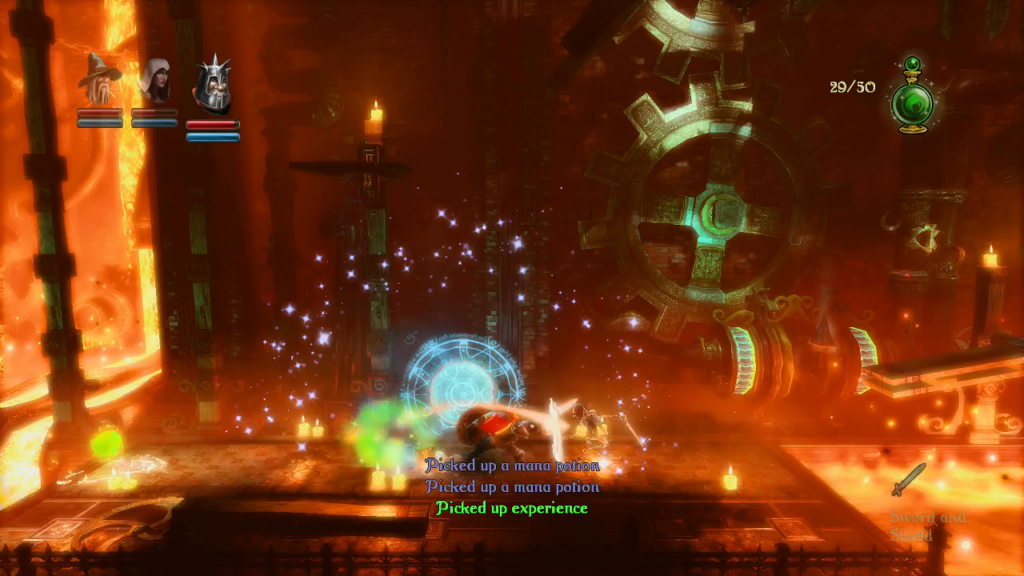
Trine is not a difficult videogame, in either its dumb and button-mashy combat or its physics-exploiting platforming. I can increase the challenge through the traditional means with an Easy, Medium, and Hard mode. A more interesting option is the Hardcore toggle, which may be activated on any difficulty. This mode disables mid-stage saving and resurrections from the magic mirror.
Trine becomes a completely different trial when a player character’s death—particularly the Thief or the Wizard—sticks for the rest of the stage, forcing their partners to overcome obstacles without the abilities meant to overcome them. Some of these obstacles become impossible to pass, making this a much more difficult option, but not in a particularly intelligent way. I will only play Hardcore Mode when I’m desperate for something new to do. I may never be that bored.
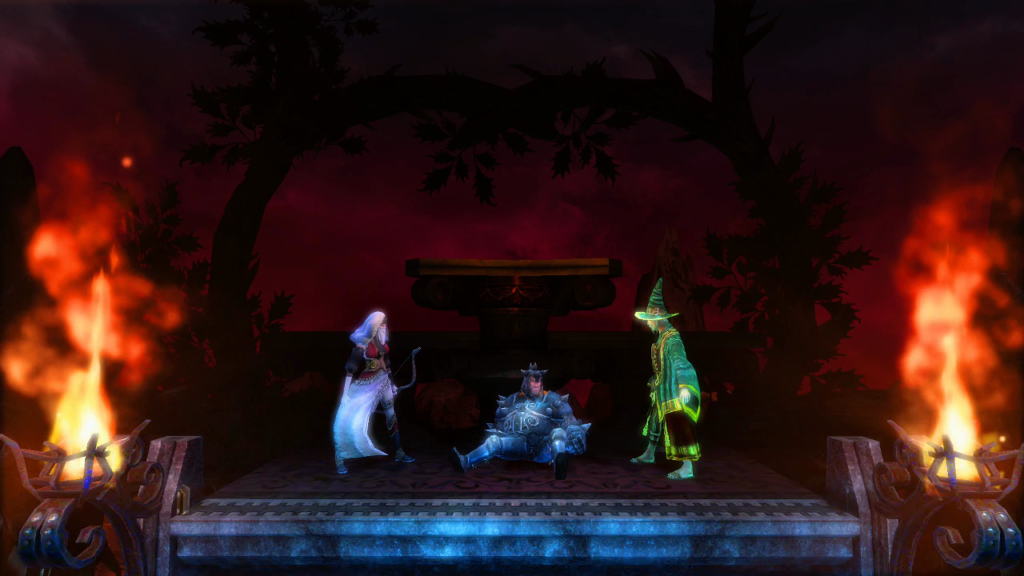
Trine is an enjoyable puzzle-platformer, though I find my appraisal burdened by caveats. I like the premise of switching between three player characters to solve puzzles and bypass obstacles. I am disappointed that their skill sets are so specialized that moments where they build their skills off each other are rare. The stage and puzzle design is so rigid that the potential for creative solutions to problems feels stymied. Each stage can be clearly divided into segments themed to each character, and I can point with bored intonation to each in turn: This is where I play as the Wizard, and here I switch to the Thief, then here I’ll be the Knight. The optional difficult modifiers do little to remedy this feeling. Despite these misgivings, Trine’s dated physics engine makes it feel unique and memorable. It’s a fine time, if a rigid one.